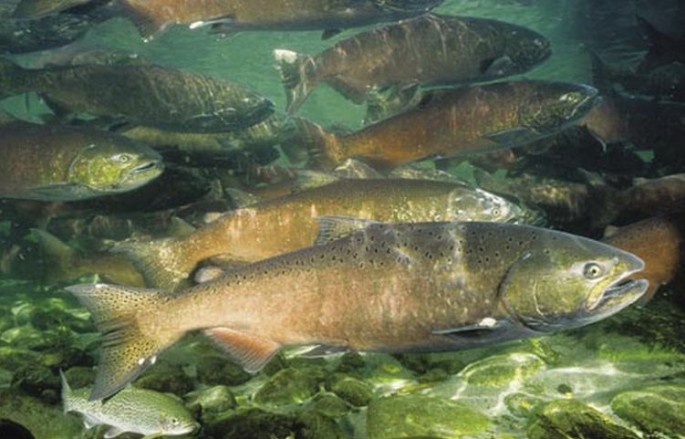Using isotope tracking and examining "growth rings" in the ear bones of Chinook salmon have given scientists the means to pinpoint the spawning grounds of this species and also a way to protect it from extinction.
Researchers at the University of Alaska Fairbanks discovered a chemical signature on the ear bones (or otolith) of Chinook salmon (Oncorhynchus tshawytscha) captured from Alaska's Bristol Bay region in 2011. They observed the otolith grows layers as the fish grows, and these "growth rings" persist throughout the life of the salmon.
The team also found traces of the element Strontium in the otolith. Strontium is usually found in bedrock.
Its quantity in the otolith varies depending on location and is trapped in the otolith as the salmon swim. Researchers observed the chemical signature remains the same despite the salmon swimming in different waters.
By measuring strontium isotope ratios in different layers of otoliths from salmon caught at sea, researchers from the universities of Utah, Washington and Alaska Fairbanks and the U.S. Geological Survey determined not just the watershed, but a set of streams where the salmon hatched and grew before migrating downstream to the ocean.
The new fish-tracking method may help pinpoint critical habitats for fish threatened by climate change, industrial development and overfishing.
"Each fish has this little recorder, and we can reveal the whole life history of the fish from the perspective of the otolith. Each 'growth ring' is a direct reflection of the environment the fish was swimming in at the time it was formed," said Sean Brennan, study leader and a postdoctoral researcher in the University of Washington's School of Aquatic and Fishery Sciences.
Researchers were able to trace the birthplace of the salmon and the places it had been to. They found the Chinook salmon were born in the Nushagak watershed and stayed there for a year before migrating to the ocean.
"Using this method, we can trace where the salmon were born and where they moved while they were growing in the rivers and streams," said University of Utah geochemist Diego Fernandez, a co-author of the study published May 15 in the journal Science Advances.
"This could be useful for protecting fish and understanding how many salmon we can take from nature."
The researchers believe that this technique could help them explain the declining population of the Chinook salmon. Such information can pave way in the development of efforts that can help conserve the species.
Chinook salmon are listed on the Endangered Species List, said the National Wildlife Federation. They are endangered in the Columbia River tributaries and California breeding sites, and threatened in a range of rivers and streams throughout Oregon, Idaho and Washington states.
The Chinook salmon is an important keystone species of the Pacific Northwest. It's a vital food source for a diversity of wildlife, including orca whales, bears, seals and large birds of prey. Chinook salmon is also prized by people that harvest salmon both commercially and for sport.
In the new study, researchers from the universities of Utah, Washington and Alaska Fairbanks and the U.S. Geological Survey analyzed strontium isotope ratios from 255 Chinook salmon caught in southwestern Alaska's Bristol Bay.
The study determined where the fish hatched and spent time in seven different sets of two to five streams within the watershed of the Nushagak River, western Alaska's third-largest river.
The researchers believe their method will work on other salmon and fish species and in other settings where the geology produces varying strontium isotope ratios in different streams.
Brennan and Fernandez did the study with Thure Cerling, Christian Zimmerman of the U.S. Geological Survey in Anchorage, and Megan McPhee and Matthew Wooller of the University of Alaska Fairbanks. The USGS and Alaska Sea Grant funded the study.



























